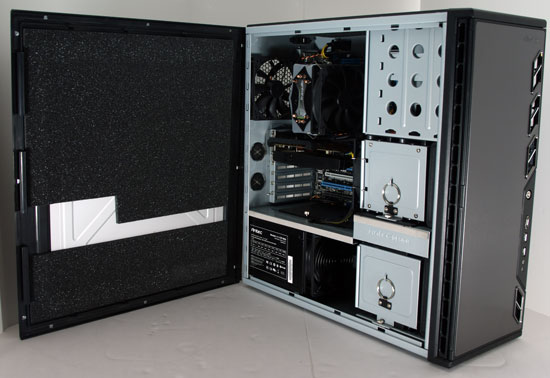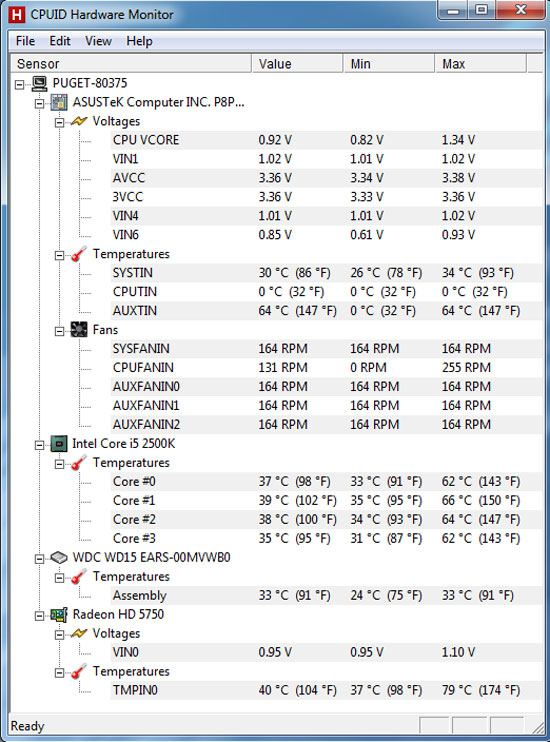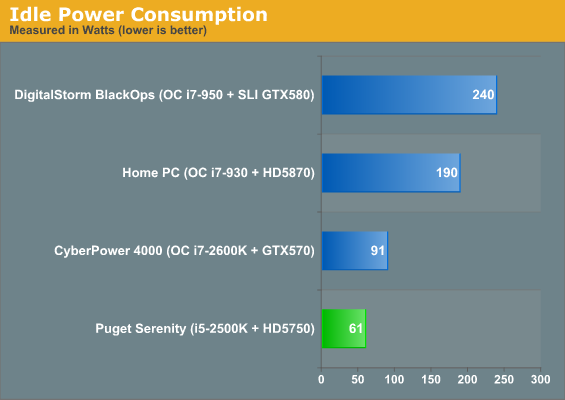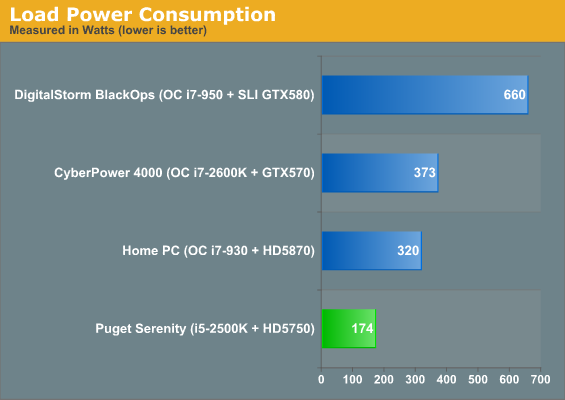Puget Systems Serenity SPCR Edition: Blissful Silence
by Dustin Sklavos on February 10, 2011 12:00 AM EST- Posted in
- Systems
- Intel
- Radeon
- Sandy Bridge
- Puget Systems
- Serenity SPCR
Build, Noise, Heat, and Power Consumption
Given the somewhat exotic nature of Puget Systems's Serenity SPCR Edition tower, it's reasonable to assume that there just aren't any good corners to cut. I'm happy to report that, having examined the system, Puget Systems simply couldn't and didn't.
What makes the build particularly interesting compared to the others is that, as I mentioned in the introduction, this really is a custom build, not just a melange of carefully chosen and assembled parts. Take a look inside and see what I mean.

Seeing the additional foam padding on the inside of the side panel when I had to remove the internal packing was a major cue, and the foam has been carefully cut to fit around the internals of the Antec P183 case used for the build. From the photo you can see three major points in Puget Systems's favor: quality case, quality power supply, and additional custom sound dampening. What's harder to see is that Puget Systems removed the Antec Tricool fans from the case and replaced them with silent Scythe 120mm fans. They've also bracketed an additional fan to the top hard drive tray, and they've removed the top exhaust fan and covered the vent with foam.
Another interesting point is the use of an air cooler instead of a watercooling system on the processor. I've reviewed more desktops with watercoolers than not and they're generally considered among the quietest ways to go, but here Puget Systems opts to use an air cooler—the Gelid Tranquilo—with a silent fan. They also carefully tuned the fan speeds in the ASUS board's UEFI to ensure silent running.
Certainly building the entire system for low noise is going to mean running a little hotter than normal, though, right? Interestingly, that's not the case.

Check out those thermals. The Serenity SPCR Edition keeps everything running remarkably frosty, and that's due in no small part to the attention paid to airflow inside the case. The P183 was already an excellent case with great thermals (we actually have a review unit on hand and we'll be posting a case review in the coming months), but the modified cooling produces airflow moving in effectively a straight line through the tower with minimal turbulence, allowing the fans to run at low speeds without compromising thermal performance. Even the Radeon doesn't crack 80C.
With those temperatures and the system's configuration in mind, these power consumption figures should come as no surprise to you:


We tested power consumption by idling at the desktop, and then running our Left 4 Dead 2 timedemo. In my experience, very few games are capable of pulling as much power from a system as Left 4 Dead 2 can. Something about the Source engine's relatively frugal usage of graphics hardware lets the processor and video power consumption scale well together.
Under load, Puget Systems's Serenity SPCR Edition draws less power than my fairly frugal desktop does at idle. Sandy Bridge has proven to be stunningly power efficient in the testing we've been able to do (we really can't wait to get our hands on more Sandy Bridge-equipped notebooks), and combining that with the already efficient Radeon HD 5750 keeps power consumption low. The next system up on the list—my home tower—draws nearly twice as much power under load. That increase in power draw may be commensurate with the increase in gaming performance, but keep in mind the i5-2500K is able to handle processor-intensive tasks much more efficiently than the i7-930.
















139 Comments
View All Comments
Kaleid - Friday, February 11, 2011 - link
should have a 500rpm fan added to it, 79C is not cool.flemeister - Friday, February 11, 2011 - link
It's well within spec. Also, a fan mounted on the video card would need to be mounted horizontally, which would encourage ticking/scraping noises from the fan (I've got a similar rig, gone through this stage before). These noises would be noticeable in a rig this quiet.And if you choose a fan that's not susceptible to such noises, you encounter motor noise, a buzzing sound that reminds you why Puget chose the sleeve-bearing Scythe Slipstream fans - they sound absolutely perfect: no buzzing, no unwanted noise at all. I'm using three of the 800RPM models in my rig as we speak, and I couldn't be happier with them!
coffeejunkee - Friday, February 11, 2011 - link
Nice try but there is only one way to go with this configuration: Thermalright HR-02 on the cpu and HR-03 GT on the gpu. It won't get more quiet than this.Chris Peredun - Friday, February 11, 2011 - link
I know Dustin didn't want to go into the "30fps" discussion, but I'm really, really tired of seeing that statement getting bandied about the Internet.There is a very, very clear difference between 60 and 30fps. If you disagree, I'm afraid you are simply wrong.
There.
I said it.
*draws line in the sand*
Dustin Sklavos - Saturday, February 12, 2011 - link
There absolutely is and I believe I suggested as much.That said, in my experience (and for most of the industry) 30fps seems to be the magic number for playable smooth framerate in gaming. Certain games look like crap at 30, though, while others (Crysis) can actually dip below it and still feel pretty smooth.
Chris Peredun - Saturday, February 12, 2011 - link
*shakes head and respectfully gestures to the other side of the line*The confusion is that ~24fps (and around 30fps) is the lower threshold of motion, where you stop seeing individual frames and start seeing continuous movement.
Yes, 30fps is smooth. Yes, it's playable. But 60fps is noticably better, especially when the game is fast-paced. Something like WoW won't suffer nearly as bad as a twitch FPS, for example.
The easiest way to relate the 60-vs-30 argument is to ask people if they can see the difference between something like a live-action sports event or soap-opera (both typically shot and broadcast 60fps) and a "major network TV show" typically shot and broadcast at 24/30fps.
Or have a look at the sample video here, recorded from Way Back When UT2004 was considered new:
http://kimpix.net/2006/12/03/60fps-vs-24fps/
If you're *happy* with 30fps, you've probably saved a lot of money on video cards over the years by not needing anything above that. But please don't try to write it off as an academic difference. 100 vs 150, I'll accept as being academic simply because most people still run 60Hz monitors.
ClagMaster - Sunday, February 13, 2011 - link
"And finally, a brief thumbs up for including 8GB of DDR3 instead of 4GB in the review unit. This really should be standard and it's perplexing why so many of our review towers don't ship with 8GB at this point."Thats mighty magnamimous of you that you gove a "brief thumbs up" have 8 GB of memory on your review unit.
Your comment is silly.
I seriously wonder if you ever used over 30% (2.4 GB) of that memory in your test reviews.
There are plenty of people who have used PC's for 25 years who consider 32-bit Operating Systems and 4 GB of DDR3 memory more than adequate for most mainstream applications which includes DVD and BlueRay encoding.
How about you load a 32-bit Windows XP Home or Pro OS on this nice quiet Sandy Bridge Boutique PC with 4 GB of DDR3 memory and see how much more efficient this computer would be.
Just do it and post the results.
HangFire - Tuesday, February 15, 2011 - link
"Just do it and post the results."I hope they do.
I've run XP and 7 on identical systems, and even the same system. XP has inexplicable delays in bootup and network operations that don't plague 7. Having an extra 4GB of dynamically available disk cache really helps in SSD/HDD systems.
xbmchtpcfan - Sunday, February 13, 2011 - link
I think one important aspect that everyone is failing to call out is what is your time worth to you? Many of you talk about putting together your own rig for cheaper, yet fail to realize you are spending your time to do that. What is that time worth to you? Many of you will just chalk this time up to a 'hobby', but I have lots of hobbies, spending time with my family and friends among the top.And yes, I am technically competent enough to order all the parts and put a somewhat silent machine together for a cheaper base cost. But between researching, ordering the parts, assembling, testing, etc, how much time will I really put into this?
Since most of you want to put dollars next to it, I'll give an example of something with dollar value. If you could consult in your field of expertise, is the 30 hours spent better than consulting on the side for, say, $50 an hour? Now your opportunity cost is $1500 of lost revenue vs an additional cost of $700 (rough estimates) for the Puget system.
Given the above example, many of you will say that if you are able to consult for $50 an hour outside of your normal day job, than you can probably afford to pay whatever you want, so let's take look at non-monetary examples. Is it time better spent than staining your deck? Landscaping? Is it time better spent than reading to your daughter or watching her walk for the first time?
The answer to all of these may be yes to you, but to others, they may have different priorities and different hobbies that they like to do. If you want to know what types of target consumers Puget is looking for, it's the ones that realize that their time is worth something and that there is an opportunity cost associated with anything that requires your time and effort.
As for me, I am in this market, so for me, it is about reviewing all the boutique shops that offer this type of quiet machine and factoring in everything they have to offer based on the price of the system. From what I can tell, Puget is near or at the top of the list. I'll likely wait for the Sandy Bridge fiasco to blow over and see what Puget does with the Radeon HD 6850 to get a little more gaming power out of a silent machine. So there you have it, one AT reader that is in the target market.